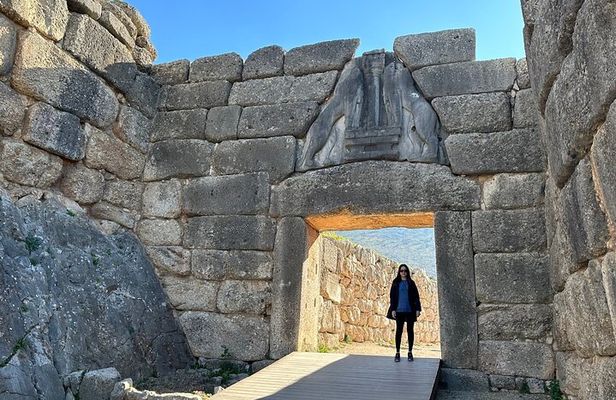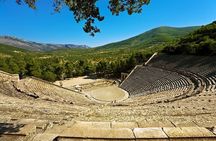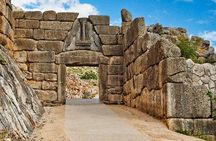
No expiration date
Easy refund
Free exchange
Easy booking
Mycenae Epidaurus Nafplio Isthmus Canal Private Luxury Tour
$439.16
This is an experience gift voucher. The recipient will book the experience after
they redeem the gift voucher.
Overview
Journey through Greece’s legendary past on this captivating tour of the Corinth Canal, Mycenae, Epidaurus, and Nafplio!
Begin at the engineering marvel of Corinth Canal,where the Aegean and Ionian Seas nearly meet. Then, explore Mycenae the mighty kingdom of Agamemnon, where you’ll walk among ancient Cyclopean walls and the legendary Lion Gate.
Next, stand in awe at Epidaurus home to the world-famous ancient theater with perfect acoustics—still used today! Finally, wander the **romantic streets of Nafplio , Greece’s first capital, with its Venetian fortress, seaside charm, and vibrant cafes.
This full-day tour blends mythology, history, and breathtaking landscapes into one unforgettable experience. Perfect for history lovers, culture seekers, and photographers alike!"
Begin at the engineering marvel of Corinth Canal,where the Aegean and Ionian Seas nearly meet. Then, explore Mycenae the mighty kingdom of Agamemnon, where you’ll walk among ancient Cyclopean walls and the legendary Lion Gate.
Next, stand in awe at Epidaurus home to the world-famous ancient theater with perfect acoustics—still used today! Finally, wander the **romantic streets of Nafplio , Greece’s first capital, with its Venetian fortress, seaside charm, and vibrant cafes.
This full-day tour blends mythology, history, and breathtaking landscapes into one unforgettable experience. Perfect for history lovers, culture seekers, and photographers alike!"
—
ARGOLIS TOUR : Mycenae Lions Gate Epidaurus & Nafplio Full Day Private Tour 8H
Isthmus Canal
Pickup included
Isthmus Canal
Pickup included
Tour guide
Language: English
Human tour guide
Duration: 9 hours 15 minutes
- Private Transportation
- Groups of 4-7 people are transported in comfortable mini vans.
- All vehicles with WiFi, A/C, Bottled Water
- Fuel - Tolls included
- Expert English-speaking Tour Drivers with extensive historical knowledge
- Transportation via modern, first-class private vehicle
- Car Seats: Book in advance if you require infant or child seats.
- This is a private tour, you can customize the program according to your needs
- Groups of 1-3 people are transported in luxurious sedan vehicles.
- Pick-up and drop-off service: Athens Hotel, Airbnb residence or Port
- Meal in Nafplio - Lunch stops are scheduled, but meal costs are not included.
- Kindly note that gratuities and tips are not included in the price and are left to your discretion.
- Optional airport pick-up, available at an additional cost.
- Licensed guide to accompany you into archaeological sites
- Entry/Admission - Palamidi Castle
- Entry/Admission - The Ancient Theatre of Epidaurus
- Entry/Admission - Epidaurus Archaeological Museum
- Entry/Admission - Archaeological Museum of Ancient Mycenae
- Entry/Admission - Archaeological Site Mycenae
- Entry or admission fees for archaeological sites
Meeting point
Return details
-
Corinth CanalThe Corinth Canal is a waterway that crosses the narrow isthmus of Corinth to link the Gulf of Corinth to the Saronic Gulf. As such, the canal separates the Greek mainland from the Peloponnese, turning it into an island The canal, though executed in the late 19th century, has been a 2000-year-old dream. Before its construction, ships in the Aegean Sea that wanted to cross to the Adriatic or anchor in Corinth, a rich shipping city, had to circle the Peloponnese, which would prolong their journey an extra 185 nautical miles. It is believed that Periander, the tyrant of Corinth (602 BC), was the first to conceive of the idea of digging the Corinth Canal. As the project was too complicated given the limited technical capabilities of the times, Periander constructed the diolkos, a stone road which allowed ships to be transferred on wheeled platforms. The Corinth Canal connects the Gulf of Corinth in the Ionian Sea with the Saronic Gulf in the Aegean Sea.
- The archaeological site of Mycenae comprises the fortified acropolis and surrounding funerary and habitation sites, which are located mainly to its west and southwest. Most of the visible monuments date to the centre's great floruit, from 1350 to 1200 BC. Great Cyclopean walls surround the almost triangular acropolis, which is accessed from the northwest through the famous Lion Gate, the symbol of the Mycenaean rulers' power. The gate was named after the two opposing lions carved in relief and set into the relieving triangle, a typical feature of Mycenaean architecture, over the door. (pass by)
-
MycenaeThe fortified citadel of ancient Mycenae, the seat of the mythical and mighty King Agamemnon. An impressive and well-preserved site, the city of Mycenae gave its name to an entire civilization. Admire sites such as the Tomb of Clytemnestra, the infamous Lion’s Gate, the Cyclopean walls and learn of their blood-stained past. In the second millennium BC, Mycenae was one of the major centres of Greek civilization, a military stronghold which dominated much of southern Greece, Crete, the Cyclades and parts of southwest Anatolia. The period of Greek history from about 1600 BC to about 1100 BC is called Mycenaean in reference to Mycenae. At its peak in 1350 BC, the citadel and lower town had a population of 30,000 and an area of 32 hectares.
-
Archaeological Museum of Ancient Mycenae‘Rich in Gold', the kingdom of mythical Agamemnon, first sung by Homer in his epics, is the most important and richest palatial centre of the Late Bronze Age in Greece. Its name was given to one of the greatest civilizations of Greek prehistory, the Mycenaean civilization, while the myths related to its history have inspired poets and writers over many centuries
-
Lion GateThe Lion Gate was the main entrance of the Bronze Age citadel of Mycenae, southern Greece. It was erected during the 13th century BC, around 1250 BC, in the northwest side of the acropolis and is named after the relief sculpture of two lionesses or lions in a heraldic pose that stands above the entrance. The Lion Gate is the sole surviving monumental piece of Mycenaean sculpture, as well as the largest sculpture in the prehistoric Aegean. It is the only monument of Bronze Age Greece to bear an iconographic motif that survived without being buried underground, and the only relief image which was described in the literature of classical antiquity, such that it was well known prior to modern archaeology.
-
The Ancient Theatre of EpidaurusThe Ancient Theatre of Epidaurus is a theatre in the Greek city of Epidaurus, located on the southeast end of the sanctuary dedicated to the ancient Greek God of medicine, Asclepius. It is built on the west side of Cynortion Mountain, near modern Lygourio, and belongs to the Epidaurus Municipality. It is considered to be the most perfect ancient Greek theatre with regard to acoustics and aesthetics. The monument retains the characteristic tripartite structure of a Hellenistic theatre that has a theatron, orchestra, and skene. During Roman times, the theatre (unlike many Greek theatres) did not suffer any modifications.
-
Citadel and Treasury of AtreusThe Treasury of Atreus or Tomb of Agamemnon is a large tholos or beehive tomb on Panagitsa Hill at Mycenae constructed during the Bronze Age around 1250 BC. The stone lintel above the doorway weighs 120 tons, with approximate dimensions 8.3 x 5.2 x 1.2m, the largest in the world. The tomb was used for an unknown period. Mentioned by the Roman geographer Pausanias in the 2nd century AD, it was still visible in 1879 when the German archaeologist Heinrich Schliemann discovered the shaft graves under the "agora" in the Acropolis at Mycenae.
-
EpidavrosThe Epidaurus amphitheatre: Famous for its classic Greek construction and astounding acoustics. Enjoy the arts! Be captivated by the theatrical performances from Euripides, Sophocles, Aristophanes and Aeschylus. Drop a pin or coin on the stage... it will be heard even if you are sitting at the last seats of the theater. The Epidaurus Archaeological Museum: Noted for its reconstructions of temples and its columns with inscriptions. The Asclepius: The sanctuary dedicated to the ancient Greek demi-god of medicine Asclepius. A marvelous ancient medical retreat.The Ancient Theatre of Epidaurus is a theatre in the Greek city of Epidaurus, located on the southeast end of the sanctuary dedicated to the ancient Greek God of medicine, Asclepius. It is built on the west side of Cynortion Mountain, near modern Lygourio, and belongs to the Epidaurus Municipality. It is considered to be the most perfect ancient Greek theatre with regard to acoustics and aesthetics.
-
Epidaurus Archaeological MuseumArchaeological Museum of Epidaurus is a museum in Epidaurus, in Argolis on the Peloponnese peninsula, Greece. The museum, noted for its reconstructions of temples and its columns and inscriptions, was established in 1902 and opened in 1909 to display artifacts unearthed in the ancient site of Epidaurus in the surrounding area.The museum is located in the archaeological site of the sanctuary of Asclepius. It hosts architectural parts from the temple and the buildings of the shrine, as well as inscribed columns and pedestals, altars, bronze medical equipment, sculpted votive offerings and tablets, representations of the Asclepius temple (4th c. BC), and sections of the Tholos. The museum was built by P. Kavadias during the period 1902-1909. More wings were constructed in time to house the sculptures, the pottery and the collection of inscriptions that came progressively came to light during the excavations on the site.
-
Sanctuary of AsklepiosThe Temple of Asclepius was a sanctuary in Epidaurus dedicated to Asclepius. It was the main holy site of Asclepius. The sanctuary at Epidaurus was the rival of such major cult sites as the Sanctuary of Zeus at Olympia and Apollo at Delphi. The temple was built in the early 4th century BC. If still in use by the 4th century AD, the temple would have been closed during the persecution of pagans in the late Roman Empire, when the Christian Emperors issued edicts prohibiting non-Christian worship.
-
NafplioFree Time For Lunch Coffe Shopping Nafplio is a seaport town in the peloponnese in Greece that was expanded up the hillsides near the north end of the Argolic Gulf.The town was an important seaport held under a successsional of royal houses in the middle Ages as a part of the loardship of ARGOS and NAUPLIA .The town was the capital of the First HELLENIC republic and of the kingdom of Greece from the start of the Greek Revolution The Lion of the Bavarians It's impressive, it's huge, it's carved into the rock above Michael Iatrou Street, with a small park under its feet. The sleeping lion is the work of German sculptor Christian Ziegel, commissioned by King Louis, father of Otto, in memory of the Bavarian soldiers of Otto's dynasty, who died in Nafplio in 1833 of a typhoid epidemic. The locals, of course, say that what killed them was the many bitter things they ate, hence the other, unofficial name of the monument (echm) Agouroon.
-
Palamidi CastleOne of the most well-preserved castles in all of Greece, Palamidi offers spectacular views of the city from its loopholes, wonderful routes inside and terrifying terrain in the hole-prison of Kolokotronis, Palamidi is a fortress to the east of the Acronauplia in the town of Nafplio in the Peloponnese region of southern Greece. Nestled on the crest of a 216-metre high hill, the fortress was built by the Venetians during their second occupation of the area (1686–1715). The fortress commands an impressive view over the Argolic Gulf, the city of Náfplio and the surrounding country. There are 913 steps in the winding stair from the town to the fortress. However, to reach the top of the fortress there are over one thousand, while locals in the town of Nafplion will say there are 999 steps to the top of the castle.
-
Akronafplia FortressThe Akronaufplia is the oldest part of the city of Nafplio in Greece.Until the thtirteenth century it was a town on its own.The arrival of the venetians and the Franks trensformed it into part of the towns fortifications.Later part of it was used as a prison until the Greek government decided that the view provided from its location would benefit the Local Tourism.
-
BourtziEnjoy the view of the water castle of Bourtzi a Venetian Castle located in the middle of the harbor of Nafplio and take fascinating photos from the Harbor side
-
NafplioEnjoy Free Time shopping lunch at Nafplio
-
The Ancient Theatre of EpidaurusThe Ancient Theatre of Epidaurus is a theatre in the Greek city of Epidaurus, located on the southeast end of the sanctuary dedicated to the ancient Greek God of medicine, Asclepius. It is built on the west side of Cynortion Mountain, near modern Lygourio, and belongs to the Epidaurus Municipality. It is considered to be the most perfect ancient Greek theatre with regard to acoustics and aesthetics. The monument retains the characteristic tripartite structure of a Hellenistic theatre that has a theatron, orchestra, and skene. During Roman times, the theatre (unlike many Greek theatres) did not suffer any modifications.
If it’s canceled due to poor weather, you’ll be offered a different date or a full refund.
How it works?
01
—
You choose from 10,000+ experience gifts
02
—
We deliver the eVoucher or the Physical box to the recipient
03
—
Recipient books the experience and creates unforgettable memories!
Mycenae Epidaurus Nafplio Isthmus Canal Private Luxury Tour
$439.16
This is an experience gift voucher. The recipient will book the experience after
they redeem the gift voucher.
How it works?
01
—
You choose from 10,000+ experience gifts
02
—
We deliver the eVoucher or the Physical box to the recipient
03
—
Recipient books the experience and creates unforgettable memories!




